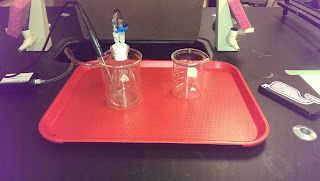This past week, we learned about particles in gas and liquids through a popcorn scent and food coloring. These main ideas connect with each other because gas and liquid particles both move, which we learned through experiments and discussions in class.
Popcorn Particles A bag of popcorn was brought into the room. We were told to raise our hand when we smelled the popcorn. The people closest to the popcorn bag smelled it instantly. The people farther back took a longer time to locate the smell. As the popcorn particles dispersed throughout the room, the scent became fainter than originally. We then created a storyboard of what we thought happened with the popcorn particles. The green dots represent popcorn particles and the purple dots represent air particles.
 |
| Storyboard of the popcorn particles traveling |
Food Coloring We were given two beakers filled with cold and hot water. We then placed a drop of food coloring in each beaker. In the cold water beaker, the food coloring stayed mostly in one spot. In the hot water beaker, the food coloring dispersed almost immediately. Therefor, we theorised that the cold water had slower moving particles and the hot water had faster moving ones. After the experiment, we created another storyboard of what we thought happened with the food coloring and hot and cold water.
 |
| Storyboard of the food coloring experiment. |
Food coloring experiment
We came to know and understand the ideas this week by completing experiments, creating storyboards, and discussing the ideas during class. I do not have any other questions relating to what we did this past week. My participation this week was mediocre because I got distracted often by my group members. I would rate my understanding of all the ideas this week a 10 because I'm sure I know and understand everything. I need to work on focusing more during class.


























